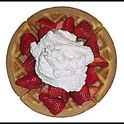New to stainless – need help with sticking!!!
So I'm relatively new to cooking and VERY new to using stainless. I took a cooking class and things worked really well with stainless so I went and got a whole set of D5. My first attempt went really well – a pork tenderloin. But then I tried to sauté a chicken breast that was coated in parmesan. I heated the pan and put a good amount of oil in it and once that was heated added the chicken. That chicken stuck like glue! I tried it again with a second chicken breast and it did the same thing. Any tips on how to keep things from sticking when you are cooking "dry" things (i.e. not much liquid)? Any tips are greatly appreciated!!
54 Comments
There are many good answers here so I won't repeat. However, I would like to chime in on the cleaning side. All Clad does NOT recommend any kind of green, blue, stainless scrubbie. All Clad does recommend Barkeepers Friend and a sponge. Don't worry about germs on the sponge just follow the microwave suggestion. I use a sponge & BKF on all my pans and have never had a problem. Some of my stainless pans are more than 20 years old and still look great!Bon Ami is a good sub. I've used it a couple of times when the market was out of BKF. Note that the rainbow that sometimes shows up on the bottom of the pan has no effect on the pan's proformance at all but does go away with the vinegar trick as mentioned. Last, should something get heavily burned on, put liquid dishwasher soap full strength directly on the stain & let sit overnight. The stain will flake off easily in the morning. Rinse very well.
Good luck with your pans!
"Kitchen sponges can grow harmful bacteria, yeasts, and molds that can make you sick.
The United States Department of Agriculture says that the best ways to kill germs on a kitchen sponge are:
Microwave the sponge on high for one minute, which kills up to 99% of germs.
Clean it in the dishwasher, using both wash and dry cycles and a water temperature of 140 degrees F or higher.
Soap and water or bleach and water do not work as well for killing germs on sponges. Another option is to buy a new sponge each week."
Make sure you have enough in the pan.
That 90% of all food poisoning originates in home kitchens resulting in thousands of deaths every year is clear evidence a lot of what we believe to be safe isn't (or at the very least we're pretty sloppy about following the rules). Sponges are banned from commercial kitchen prep areas because there is no practical method for keeping them sanitary.
Take that kitchen sponge, the one just out of the microwave. Assuming it reached the pasteurization point throughout 100% of its bazillion square inches of surface area and that you didn't burn yourself removing it from the oven, how long do you think it will take that warm, wet bacterial playground to become dangerous enough to possibly send someone to the hospital?
4 hours. Or a few seconds depending upon how it is used. And then what? A stack of towels in the drawer, like we use in commercial settings, is by far the safest answer.
Of course a very experienced cook often creates the season as they go along, just because their heat v. oil skills are so honed. If you are a savant, rock on with your bad bad self! But for the those that want insurance and a back-up plan, you can't go wrong, or waste time seasoning a valuable new pan.
Despite All-Clad (or whomever's) claims, stainless benefits tremendously from 'seasoning'. While stainless is significantly less porous than most metals, and certainly very much less porous than iron, it does still have a degree of porosity and as for use as cookware *you* benefit greatly from seasoning all your metal cookware. Follow seasoning instructions for iron, and/or make your first few efforts in your new pans tostones, or soft-shell crab, or a deep fried turkey – you will notice the difference immediately. If your seasoning ever fades and due to accidents necessitating heavy scrubbing, more tostones! I recommend honey-lime yogurt dipping sauce with that, but that's just me.
Happy Thanksgiving!!!
In the event of sticking, but not yet burnt, a wet sauce can be deployed, and all the good stuff stuck to the bottom can be scraped up into it.
Simply leave the pan in the sink, add hot water,, and add dishwashing soap(like Cascade)-not much; just lightly over surface, then leave it alone for awhile. Same method shines my sink!
I don't think a green scrubby could do anything detrimental to a stainless pan (other than to the outside polished surfaces) so if the bottoms are visibly clean, you should be okay from that standpoint. Stainless is inherently non-stick so usually a problem is due to technique. I always hesitate to blame the tools but it could be the cookware's construction is part of the problem due to uneven heating. Emphasis on the word "part", witness the occasions I'm called on to cook with 60+ year-old warped and battered Revere Ware or K-Mart Blue Light Specials in rental units.
To scrub my stainless pans, I use one of those stainless steel-wool looking scrubbers and move in a circular motion around the pan, following the "grain" of the metal.
For me the biggest thing about sticking is not to mess with the food too quickly - let it cook enough to separate from the pan on its own. And not to overcrowd the pan so things can stay hot enough. I have a hard time with it though!
Mr. Science stands corrected. Apparently the MSDS he referenced was either obsolete (it was dated way back in 2011) or someone at Bon Ami is behind on their paperwork.
The ingredients list pulled from the manufacturer's Web site this morning lists Nepheline Syenite (a different mineral abrasive), a surfactant (wetting agent), Sodium Chloride and Citric Acid. So, yes, it also cleans chemically. Basically the old salt and vinegar trick -- but much better smelling no doubt.
Mr. Science says:
Bar Keeper's Friend contains oxalic acid which chemically reacts with (oxidizes) rust, stains and culinary crud -- it cleans effortlessly without scratching. Bon Ami's Kleen King is an abrasive (quartz) cleaner.
You don't want to breathe dust from either (actually *all* dust is bad for you). But before anyone gets freaked out about oxalic acid being poisonous, it's found naturally in spinach, chives and black tea -- and of course we all know anything "natural" is "healthy". With the exception of raw rhubarb leaves but that's another thread.
Mr. Science got distracted -- what was his point? Oh, yes… The abrasive of your choice is fine for pot and pan bottoms -- just keep it away from the nice shiny new stainless. Patina must develop over time.
Umm… Banish sponges, period. Icky, eewey, full of germs and other microscopic crawly things!
We don't use sponges in my kitchens. Consider the Oxo soap dispensing dish brush with holder.
As for green scrubbing pads, you'll still need those to remove discoloration from the bottoms of your new pots and pans.
(Congrats on the acquisition. They'll last a lifetime if you don't abuse them.)
Sure, sponges can be kept sanitary -- in theory. In practice, it just doesn't happen. There's a reason they're not allowed in commercial food prep: Outside of a Petri dish, you couldn't design a better environment for growing bacteria than a damp sponge. Kitchen sponges are the most infectious source of bacteria in the home (worse than the toilet, even worse than a garbage disposal's plastic baffle). Half the people in the U.S. use the same sponge to wipe the cutting board, counter and dishes. It's no wonder 1 out of every 6 of us gets food poisoning every year. It's far easier and safer to keep a stack of cloth towels at hand, washing (with bleach) and drying between uses.
Then, as above, ensure your meat has been dried off well.
Lastly - be patient & resist the temptation to move the proteins in the first minute or so. It can still stick at this point until the surface has a chance to caramelize/crisp. If you find it's still sticking, don't touch it and wait a bit longer, then try again to move it.
Not to hijack the thread or anything, but what the heck -- let's hijack it. Anyone else want to weigh in?
The main reason to add oil to a hot pan is so that the oil doesn't get too hot while you're working on something else waiting for the pan to heat. Smoke = free radicals = carcinogenic = bad Fire is even worse (at least in the immediate timeframe).
You don't want to heat a non-stick pan dry however due to the danger of overheating the non-stick coating.
Also, banish any sponges with the dark green scrubbing pads -- those scratch stainless badly.
Finally, welcome to cooking!
And don't be too hard on yourself. We all make mistakes!











